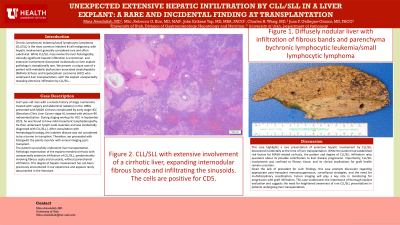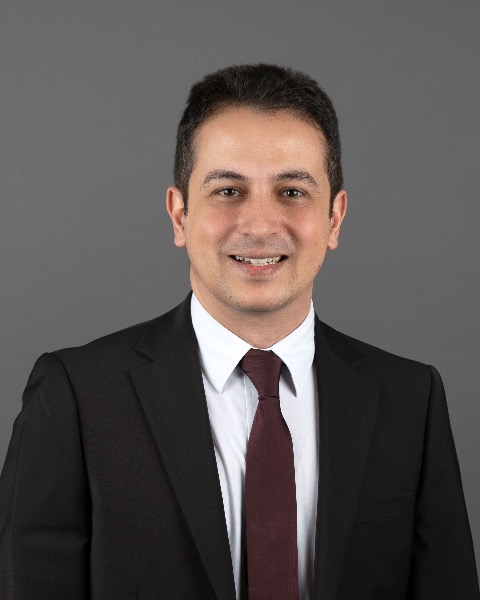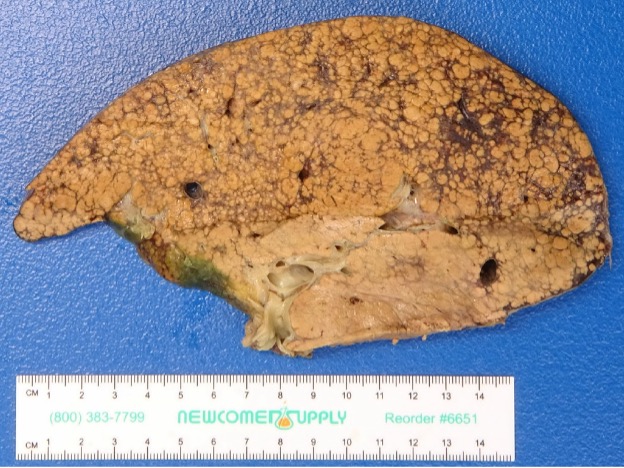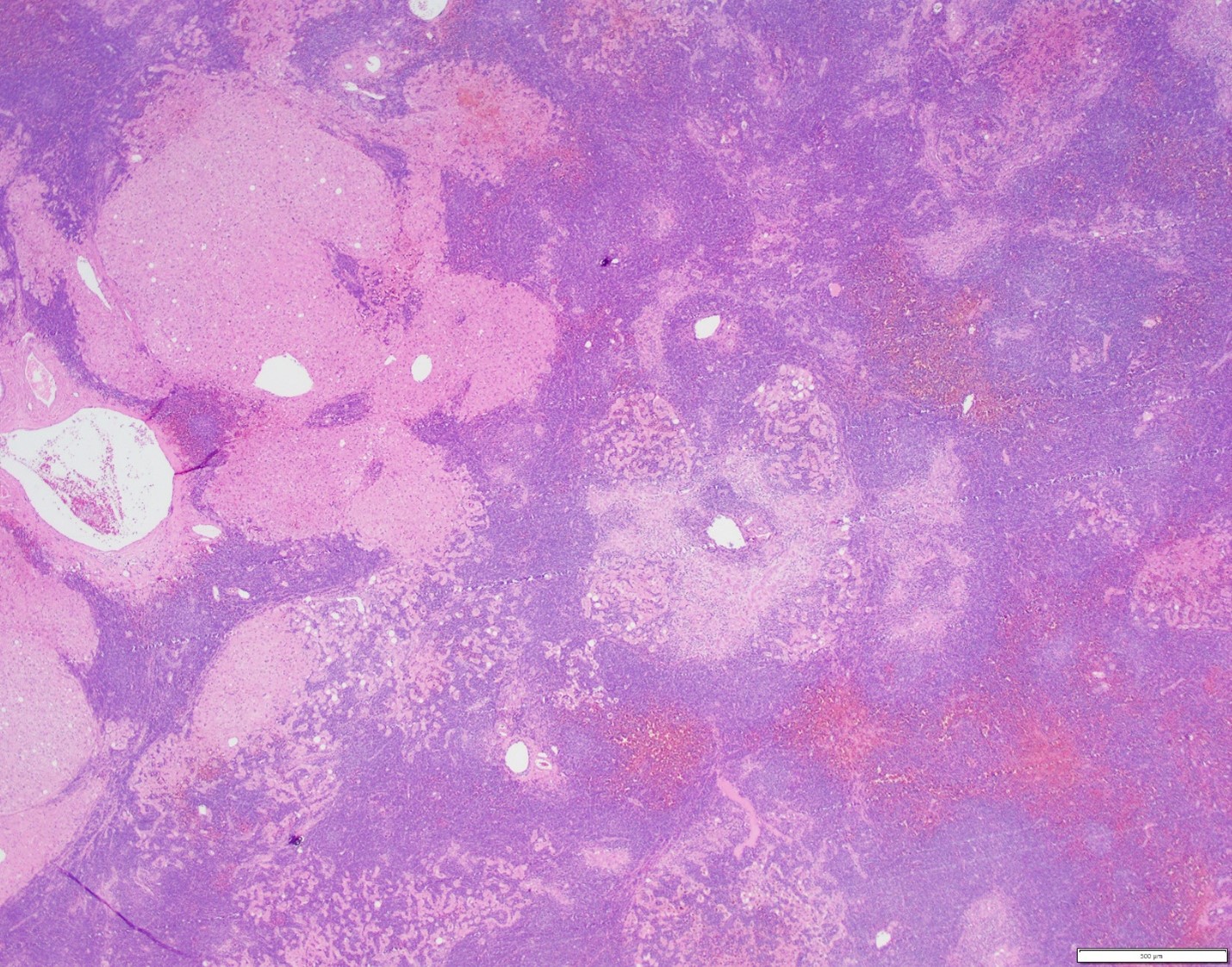Tuesday Poster Session
Category: Liver
P6150 - Unexpected Extensive Hepatic Infiltration by CLL/SLL in a Liver Explant: A Rare and Incidental Finding at Transplantation
Tuesday, October 28, 2025
10:30 AM - 4:00 PM PDT
Location: Exhibit Hall

Has Audio

Mina Awadallah, MD, MSc
University of Utah
Salt Lake City, UT
Presenting Author(s)
Mina Awadallah, MD, MSc1, Rebecca G. Kim, MD, MAS2, John Erikson Yap, MD, MBA, FACG2, Charles H. Wang, MD1, Juan F. Gallegos-Orozco, MD, FACG2
1University of Utah, Salt Lake City, UT; 2University of Utah Health, Salt Lake City, UT
Introduction: Chronic lymphocytic leukemia/small lymphocytic lymphoma(CLL/SLL)is the most common indolent B-cell malignancy, with hepatic involvement generally considered rare and often subclinical.While CLL/SLL may involve the liver histologically, clinically significant hepatic infiltration is uncommon.We present a unique case of a patient with metabolic dysfunction-associated steatohepatitis (MASH) cirrhosis and hepatocellular carcinoma (HCC) who underwent liver transplantation, with the explant unexpectedly revealing extensive infiltration by CLL/SLL.
Case Description/Methods: A 67-year-old male presented with MASH cirrhosis complicated by early-stage HCC(Barcelona Clinic Liver Cancer Stage A),treated with Yttrium--90 radioembolization. During staging workup for HCC in September 2023, he was found to have mild mesenteric lymphadenopathy.He then underwent lymph node resection and was incidentally diagnosed with CLL/SLL.After consultation with hematology/oncology, the indolent disease was not considered to be a barrier to transplant. Therefore, we proceeded with listing with the plan to monitor with annual imaging post-transplant.The patient successfully underwent liver transplantation.Pathologic examination of the explant revealed cirrhosis with unexpectedly extensive infiltration of CLL/SLL, predominantly involving fibrous septa and sinusoids, without parenchymal infiltration.This degree of hepatic involvement has not been previously encountered in our experience and appears rarely documented in the literature.
Discussion: This case highlights a rare presentation of extensive hepatic involvement by CLL/SLL discovered incidentally at the time of liver transplantation.While the patient had established risk factors for MASH-related cirrhosis, the pattern and degree of CLL/SLL infiltration raise questions about its possible contribution to liver disease progression.Importantly,CLL/SLL involvement was confined to fibrous tissue, and its clinical implications for graft health remain uncertain.Given the lack of precedent for such findings, this case prompts discussion regarding appropriate post-transplant immunosuppression, surveillance strategies, and the need for multidisciplinary coordination.Future imaging will play a key role in monitoring for progression.This case underscores the importance of thorough explant evaluation and suggests the need for heightened awareness of rare CLL/SLL presentations in patients undergoing liver transplantation.


Disclosures:
Mina Awadallah, MD, MSc1, Rebecca G. Kim, MD, MAS2, John Erikson Yap, MD, MBA, FACG2, Charles H. Wang, MD1, Juan F. Gallegos-Orozco, MD, FACG2. P6150 - Unexpected Extensive Hepatic Infiltration by CLL/SLL in a Liver Explant: A Rare and Incidental Finding at Transplantation, ACG 2025 Annual Scientific Meeting Abstracts. Phoenix, AZ: American College of Gastroenterology.
1University of Utah, Salt Lake City, UT; 2University of Utah Health, Salt Lake City, UT
Introduction: Chronic lymphocytic leukemia/small lymphocytic lymphoma(CLL/SLL)is the most common indolent B-cell malignancy, with hepatic involvement generally considered rare and often subclinical.While CLL/SLL may involve the liver histologically, clinically significant hepatic infiltration is uncommon.We present a unique case of a patient with metabolic dysfunction-associated steatohepatitis (MASH) cirrhosis and hepatocellular carcinoma (HCC) who underwent liver transplantation, with the explant unexpectedly revealing extensive infiltration by CLL/SLL.
Case Description/Methods: A 67-year-old male presented with MASH cirrhosis complicated by early-stage HCC(Barcelona Clinic Liver Cancer Stage A),treated with Yttrium--90 radioembolization. During staging workup for HCC in September 2023, he was found to have mild mesenteric lymphadenopathy.He then underwent lymph node resection and was incidentally diagnosed with CLL/SLL.After consultation with hematology/oncology, the indolent disease was not considered to be a barrier to transplant. Therefore, we proceeded with listing with the plan to monitor with annual imaging post-transplant.The patient successfully underwent liver transplantation.Pathologic examination of the explant revealed cirrhosis with unexpectedly extensive infiltration of CLL/SLL, predominantly involving fibrous septa and sinusoids, without parenchymal infiltration.This degree of hepatic involvement has not been previously encountered in our experience and appears rarely documented in the literature.
Discussion: This case highlights a rare presentation of extensive hepatic involvement by CLL/SLL discovered incidentally at the time of liver transplantation.While the patient had established risk factors for MASH-related cirrhosis, the pattern and degree of CLL/SLL infiltration raise questions about its possible contribution to liver disease progression.Importantly,CLL/SLL involvement was confined to fibrous tissue, and its clinical implications for graft health remain uncertain.Given the lack of precedent for such findings, this case prompts discussion regarding appropriate post-transplant immunosuppression, surveillance strategies, and the need for multidisciplinary coordination.Future imaging will play a key role in monitoring for progression.This case underscores the importance of thorough explant evaluation and suggests the need for heightened awareness of rare CLL/SLL presentations in patients undergoing liver transplantation.

Figure: Figure 1. Diffusely nodular liver with infiltration of fibrous bands and parenchyma by CLL/SLL.

Figure: Figure 2. CLL/SLL with extensive involvement of a cirrhotic liver, expanding internodular fibrous bands and infiltrating the sinusoids. The cells are positive for CD5.
Disclosures:
Mina Awadallah indicated no relevant financial relationships.
Rebecca Kim indicated no relevant financial relationships.
John Erikson Yap: Phathom Pharmaceutical – Speakers Bureau. Steris – Consultant.
Charles Wang indicated no relevant financial relationships.
Juan Gallegos-Orozco: Gilead – Grant/Research Support. Hanmi – Grant/Research Support. Intercept – Grant/Research Support. Mirum – Grant/Research Support.
Mina Awadallah, MD, MSc1, Rebecca G. Kim, MD, MAS2, John Erikson Yap, MD, MBA, FACG2, Charles H. Wang, MD1, Juan F. Gallegos-Orozco, MD, FACG2. P6150 - Unexpected Extensive Hepatic Infiltration by CLL/SLL in a Liver Explant: A Rare and Incidental Finding at Transplantation, ACG 2025 Annual Scientific Meeting Abstracts. Phoenix, AZ: American College of Gastroenterology.
